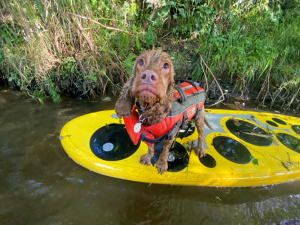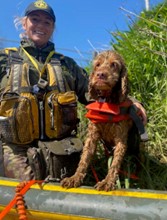Conservation detection dogs: searching for best practice – By Louise Wilson and Angela Winstanley
What the nose knows
Dogs have exceptional olfactory ability due to their nasal physiology with 125-300 million olfactory cells (Dickey and Junqueira, 2021), enabling both sensitivity and specificity. Their odour discrimination abilities far exceed that of humans who rely predominantly on vision and hearing. Our co-evolution with dogs has resulted in development of shared intellect and social skills, facilitating cooperative partnerships for a plethora of activities including detection work.
Deploying detection dogs to locate endangered or invasive species for conservation purposes is not a new concept. The earliest recorded use of detection dogs in conservation was in the 1890’s when they were successfully trained to locate New Zealand Kiwi and Kakapo (Beebe et al., 2016).
Use of conservation dogs has increased globally, and they are deployed to detect an ever-expanding number of species from insects to whales. A recent systematic review of 1,220 publications found that reports exist for the use of conservation detection dogs in 62 countries from 1930 to 2021 (Grimm‐Seyfarth et al., 2021). The review revealed the full range of target species including 408 animals, 42 plant, 26 fungi and six bacteria species.
In the United Kingdom (UK) conservation dogs are deployed for many target species, examples include bat carcass, water vole, pine marten, great crested newts, and hedgehogs (Fig 1).

Fig 1. Wildlife detection dog Henry is the first in the UK to be trained to locate hedgehogs with PTES and BHPS for Lucy Bearman Brown PHD. Henry is pictured here passively indicating to trainer and handler Louise Wilson owner of Conservation K9 Consultancy.
Dogs are the perfect tool for locating cryptic species, they are versatile, accurate, fast, highly mobile, and generally cause less disruption and damage to habitats than other survey methods. Grimm‐Seyfarth et al. (2001) systematic review examined 611 cases comparing efficacy of conservation dogs to other monitoring methods. The authors found that in 88.71 % of cases conservation detection dogs outperformed other methods such as camera traps, experienced human surveyors, hairs snares and scent stations. In the 11.3 % of cases where dogs did not perform better, training issues were generally to blame. Therefore, trainer and handler knowledge and skill are crucial for effective canine performance.
Canine credentials
When considering the suitability of dogs for conservation detection work a multifactorial approach is required, no single breed, or trait will guarantee a successful outcome. Firstly, all dogs should be assessed by a practising veterinary surgeon to ensure that they are free of health issues and are physically fit, this is essential from a welfare and performance perspective. Good structural conformation is desirable for optimal athletic performance and reduces the risk of injury (Zinc and Schlehr, 2020). Scenting ability and drive are of obvious importance. The ideal specific morphological characteristics such as height, coat type, weight and paw size will depend upon the environment in which the animal will be operating in. Consideration should be given to whether the search area is aquatic or terrestrial, temperature levels, humidity, vegetation type and height, and terrain such as sand, mud, or rocks (DeMatteo et al., 2019).
Temperament and energy levels of individual dogs should also be assessed, persistence and boldness are traits which are desirable. Some behavioural traits may make a dog unsuitable, for example, high prey drive, this is particularly important in conservation work where the dog will be exposed to many free ranging prey species. Behaviours that may damage the target are also unwelcome such as digging, coprophagia or urinary marking. Dogs must also be sufficiently motivated by and under the control of ‘reinforcers’ such as toys or food presented by the handler, these must be more salient to the dog than competing environmental stimuli.
Dogs must be confident and motivated in a range of operational working conditions, such as construction sites, or wind turbine farms, in addition to means of transport, which may vary from vehicles, boats, helicopters, or paddleboards (Fig 2). Dogs must not be fearful or anxious as this will result in suboptimal performance and poses welfare and ethical concerns. The preferences of the animal should also be considered, some dogs may find target odours aversive or may dislike water or dense cover. Giving dogs control, choice, and agency where appropriate is important for their wellbeing.

Fig 2. Hettie the water vole detection dog finds aquatic work positively reinforcing. The flotation vest and paddle board have become conditioned stimuli for positive consequences- tennis ball play.
Handler skills
Credible handlers have embedded knowledge, experience, and skills. They must be able to recognise and interpret canine body language and read canine emotional states and subtle communication signals. Handlers must be aware that canine learning occurs whenever the animal is exposed to environmental and social stimuli in day-to-day life and not just when actively training. Therefore, a clear understanding of the core principles of learning theory science and the ability and to apply these in practice is crucial for working effectively with dogs.
Good observational skills are essential, handlers need to concentrate on the dog and focus on the immediate environment and the target scent. Handlers must avoid being distracted by unrelated environmental points of interest. Physical and mental endurance are also core attributes for handlers, with two key factors being commitment and resilience when withstanding long hours of training and operational deployment.
Handlers should also have good knowledge of dog health, husbandry, and welfare needs, for example, the normal and abnormal parameters for temperature, respiration, and heart rate as well as first aid techniques. They must be prepared to meet the cost of equipment, veterinary care, nutritional requirements, housing, air-conditioned transport, and insurance. A thorough understanding of the legislation surrounding dogs is also essential.
Training takes time and dedication
Training detection dogs and developing the skills and experience required to handle them takes extensive time and unequivocal dedication to achieve the highest standards of performance. Training Conservation dogs can have greater complexities than other detection work due to environmental variables.
To give an indication of the amount of time and experience required, it is useful to look at best practice in other countries. New Zealand has the longest history of deploying conservation dogs, and they set the precedent for excellent practice with rigorous training and assessment. In contrast to the UK, New Zealand conservation dog handler teams must be certified to work on government projects, public conservation land, or in the presence of protected species. The Department of Conservation operates the ‘Conservation Dogs Programme to Undertake Work.’ This programme requires handlers to have experience of the target species, dog handling and training experience, and takes 18 -24 months of daily training to certify a handler and their dog. Entry to the programme requires an interim assessment for dog obedience and control. Full certification is issued for a three-year period after which re-testing is performed, teams must also have ongoing training to ensure competency.
Sniffing out excellence
In the UK there is a lack of government regulation and assessment of conservation detection dog trainers and handler teams. The term dog handler / trainer is not a protected title which means anyone can use it, in essence a pet dog owner with very little experience could advertise their services and attempt to undertake conservation detection work. Cognitive bias can lead people with little knowledge to overestimate their ability, known in the field of psychology as the Dunning Kruger effect. Handlers may also show leniency bias when assessing their own dogs performance (Clarke, 2020).
Lack of regulation presents significant welfare and ethical concerns for both the target species and dogs, in addition to the risk of inaccurate data negatively impacting on conservation projects. The potential ethical, legal, and financial ramifications should errors be made are considerable.
Dogs teams must be accurate and effective to contribute positively to conservation efforts. This is an important and highly skilled field, training of handlers and dogs needs to be regulated and recognised with robust, accurate and evidenced-based measures of performance. Implementing standards of best practice with rigorous ongoing validated performance assessment and Continuing Professional Development (CPD) will ensure competency and accuracy of handlers and dogs. This will enable those procuring operational dog teams to confidently appoint practitioners with recognised expertise, professional credibility, and excellent practice.
This blog first appeared in Animal Journal
 Louise Wilson is founder of Conservation K9 Consultancy, she has over 20 years of international experience, as a multidiscipline handler, trainer, instructor, and project manager for UK and international conservation dog detection projects.
Louise Wilson is founder of Conservation K9 Consultancy, she has over 20 years of international experience, as a multidiscipline handler, trainer, instructor, and project manager for UK and international conservation dog detection projects.
https://www.conservationk9consultancy.com/
 Angela Winstanley is a senior lecturer at Wrexham Glyndwr University. She is programme leader for ‘BSc Hons Animal Behaviour Welfare and Conservation’ and ‘FdSc Canine Behaviour Training and Performance’.
Angela Winstanley is a senior lecturer at Wrexham Glyndwr University. She is programme leader for ‘BSc Hons Animal Behaviour Welfare and Conservation’ and ‘FdSc Canine Behaviour Training and Performance’.
Beebe, S.C., Howell, T.J. and Bennett, P.C. (2016), ‘Using scent detection dogs in conservation settings: a review of scientific literature regarding their selection’, Frontiers In Veterinary Science, Vol 3, p.96.
Clark, C.C., Sibbald, N.J. and Rooney, N.J. (2020), ‘Search Dog Handlers Show Positive Bias When Scoring Their Own Dog’s Performance’, Frontiers in Veterinary Science, p.612.
DeMatteo, K.E., Davenport, B. and Wilson, L.E., (2019). ‘Back to the basics with conservation detection dogs: fundamentals for success’, Wildlife Biology, (1), pp.1-9.
Dickey, T. and Junqueira, H. (2021), ‘Toward the use of medical scent detection dogs for COVID-19 screening’, Journal of Osteopathic Medicine, vol. 121, no. 2, pp. 141-148.
Grimm‐Seyfarth, A., Harms, W. and Berger, A. (2021), ‘Detection dogs in nature conservation: A database on their world‐wide deployment with a review on breeds used and their performance compared to other methods’, Methods in Ecology and Evolution, Vol 12, No. 4, pp. 568-579.
Zink, C. and Schlehr, M.R. (2020), ‘Working dog structure: evaluation and relationship to function’, Frontiers in Veterinary Science, p.745.
Blog posts on the CIEEM website are the views and opinions of the author(s) credited. They do not necessarily represent the views or position of CIEEM. The CIEEM blog is intended to be a space in which we publish thought-provoking and discussion-stimulating articles. If you’d like to write a blog sharing your own experiences or views, we’d love to hear from you at SophieLowe@cieem.net.
